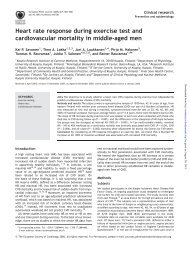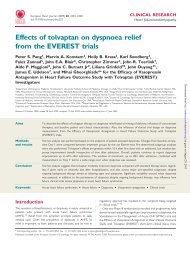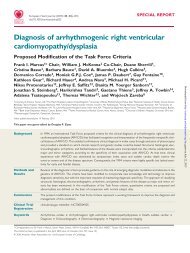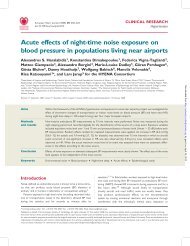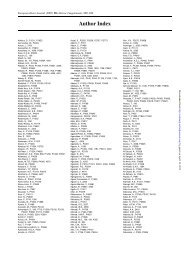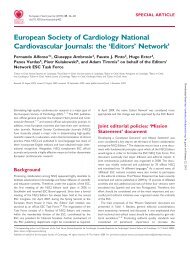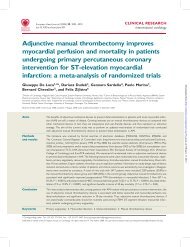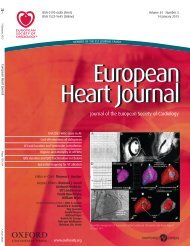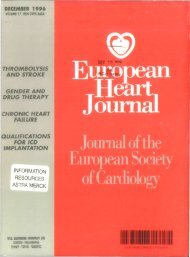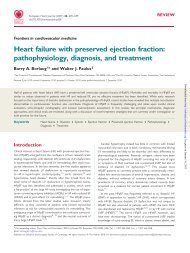Mutations in the mitochondrial thioredoxin reductase gene TXNRD2 ...
Mutations in the mitochondrial thioredoxin reductase gene TXNRD2 ...
Mutations in the mitochondrial thioredoxin reductase gene TXNRD2 ...
You also want an ePaper? Increase the reach of your titles
YUMPU automatically turns print PDFs into web optimized ePapers that Google loves.
<strong>TXNRD2</strong> and dilated cardiomyopathy 1125<br />
Table 3 Genotype distributions of non-synonymous <strong>TXNRD2</strong> variants <strong>in</strong> dilated cardiomyopathy patients and controls<br />
Nucleotide Am<strong>in</strong>o acid Genotype distributions<br />
...........................................................................................<br />
P-value<br />
DCM patients, n 5 227 (CR) Controls, n 5 683 (CR)<br />
...............................................................................................................................................................................<br />
175G . A Ala59Thr GG 222 AG 2 AA 0 (98.7%) GG 674 AG 0 AA 0 (98.6%) n.d.<br />
1124G . A Gly375Arg GG 216 AG 1 AA 0 (95.6%) GG 670 AG 0 AA 0 (98.1%) n.d.<br />
196G . T Ala66Ser 1<br />
GG 101 GT 100 TT 26 (100%) GG 282 GT 314 TT 76 (98.4%) 0.64<br />
858G . C Arg286Ser GG 224 GC 2 CC 0 (99.6%) GG 677 GC 2 CC 0 (99.4%) 0.26<br />
895A . C Arg299Ser 2<br />
AA 149 AC 70 CC 8 (100%) AA 450 AC 200 CC 26 (99.0%) 0.88<br />
1109C . T Ile370Thr 3<br />
CC 135 CT 81 TT 11 (100%) CC 353 CT 233 TT 34 (90.8%) 0.49<br />
1150G . A Gly384Ser GG 216 GA 6 AA 0 (97.8%) GG 543 GA 5 AA 0 (80.2%) 0.06<br />
Detected am<strong>in</strong>o acid exchang<strong>in</strong>g variants <strong>in</strong> <strong>the</strong> entire DCM population (n ¼ 227) and n ¼ 683 controls from a <strong>gene</strong>ral population sample (KORA S4). CR, call rate of MALDI-TOF<br />
genotyp<strong>in</strong>g. n.d., not determ<strong>in</strong>ed. Genotype distributions of <strong>the</strong> detected variants showed no significant deviation from <strong>the</strong> Hardy–We<strong>in</strong>berg equilibrium <strong>in</strong> <strong>the</strong> controls (P . 0.05<br />
for all variants). RefSNP accession IDs (rs numbers) of previously described variants: 1 rs5748469, 2 rs5992495, 3 rs2073752. Genotypes are highlighted <strong>in</strong> bold letters <strong>in</strong> <strong>the</strong> table.<br />
Figure 1 Identification of dilated cardiomyopathy-associated <strong>TXNRD2</strong> mutations (marked with arrows). (A) Sequence electropherogram<br />
from Patient 2, who was a heterozygous carrier of <strong>the</strong> 175G . A (Ala59Thr, A59T) mutation. He was also a heterozygous carrier of <strong>the</strong> synonymous<br />
variant 177C . T (Ala59Ala) (asterisks). (B) Sequence electropherogram from Patient 3, who was a heterozygous carrier of <strong>the</strong><br />
1123G . A (Gly375Arg, G375R) mutation.<br />
(Gly375Arg ¼ G375R)] <strong>in</strong> three heterozygous carriers of <strong>the</strong> 227<br />
patients (3/227 ¼ 1.3%). Both A59T and G375R were not<br />
observed <strong>in</strong> <strong>the</strong> <strong>gene</strong>ral population KORA S4 sample. The first<br />
mutation (A59T) results <strong>in</strong> a substitution of alan<strong>in</strong>e by threon<strong>in</strong>e<br />
at residue 59 of <strong>the</strong> major splice isoform (isoform 1) of <strong>TXNRD2</strong><br />
and was identified twice (2/227 ¼ 0.88%) <strong>in</strong> <strong>the</strong> 227 DCM patients.<br />
Figure 1A shows a sequence electropherogram of one of <strong>the</strong> A59T<br />
mutation carriers. Both patients carry<strong>in</strong>g this mutation were not<br />
know<strong>in</strong>gly related. The second mutation (G375R) results <strong>in</strong> a substitution<br />
of glyc<strong>in</strong>e by arg<strong>in</strong><strong>in</strong>e at residue 375 of <strong>the</strong> major splice<br />
isoform (isoform 1) of <strong>TXNRD2</strong> and was found <strong>in</strong> one of <strong>the</strong><br />
227 DCM patients (1/227 ¼ 0.44%). Figure 1B shows a sequence<br />
electropherogram of <strong>the</strong> G375R mutation carrier. Cl<strong>in</strong>ical characteristics<br />
of <strong>the</strong> three patients with novel <strong>TXNRD2</strong> mutations that<br />
were only found <strong>in</strong> DCM patients are displayed <strong>in</strong> Table 4. We<br />
obta<strong>in</strong>ed all available <strong>in</strong>formation about <strong>the</strong> three <strong>in</strong>dex patients<br />
and <strong>the</strong>ir families by contact<strong>in</strong>g <strong>the</strong> patients and <strong>the</strong>ir relatives by<br />
phone and by schedul<strong>in</strong>g visits for patients and relatives <strong>in</strong> our outpatient<br />
cl<strong>in</strong>ic. In addition, <strong>gene</strong>tic analyses <strong>in</strong> search of <strong>the</strong> mutation<br />
carried by <strong>the</strong> <strong>in</strong>dex case <strong>in</strong> relatives were performed whenever<br />
possible: Patient 1 (A59T mutation carrier) was childless and died<br />
at <strong>the</strong> age of 68. The mo<strong>the</strong>r of Patient 1 died at <strong>the</strong> age of 75<br />
due to congestive heart failure. The fa<strong>the</strong>r had a negative history<br />
for cardiovascular disease and died <strong>in</strong> World War II. The only<br />
sister of Patient 1 had atrial fibrillation and died of sudden<br />
cardiac death at <strong>the</strong> age of 69. No family members were available<br />
for cl<strong>in</strong>ical assessment and <strong>gene</strong>tic analyses. Patient 2 (A59T<br />
mutation carrier) had an entirely negative family history of DCM<br />
by hearsay. The patient was childless, had no sibl<strong>in</strong>gs, and died at<br />
<strong>the</strong> age of 65. No family members were available for cl<strong>in</strong>ical assessment<br />
and <strong>gene</strong>tic analyses. Patient 3 (G375R mutation carrier) was<br />
childless as well and also had a negative family history for DCM. He<br />
died at <strong>the</strong> age of 83. Two half-sisters and two daughters of <strong>the</strong><br />
half-sisters were available for cl<strong>in</strong>ical assessment <strong>in</strong>clud<strong>in</strong>g physical<br />
exam<strong>in</strong>ation, electrocardiogram, and ultrasound echocardiography.<br />
Cl<strong>in</strong>ical assessment, <strong>in</strong> particular LV size and function, was normal<br />
<strong>in</strong> all four relatives. Genetic analyses showed that <strong>the</strong> four relatives<br />
do not carry <strong>the</strong> G375R mutation. The discovery of two heterozygous<br />
mutations <strong>in</strong> three DCM patients raised <strong>the</strong> questions<br />
whe<strong>the</strong>r <strong>the</strong> mutations were functionally silent or important, i.e.<br />
abolish<strong>in</strong>g or impair<strong>in</strong>g <strong>the</strong> function of <strong>the</strong> enzyme. In case <strong>the</strong> variants<br />
were functionally important, <strong>the</strong> question would have to be<br />
Downloaded from<br />
http://eurheartj.oxfordjournals.org/ by guest on June 7, 2013



